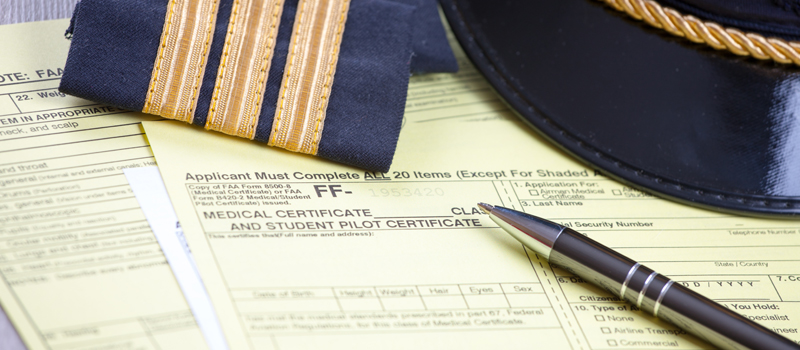

Getting your private pilot license (PPL) is one way to do it.
What’s great about a PPL is that it allows you to fly one or more kind of aircraft:
How do you get your PPL, though?
For starters, you should know the private pilot license requirements.
What are they? Let’s find out.
Note: Although you may fly several aircraft categories and classes with a PPL, this article focuses mostly on the airplane single-engine land (ASEL).
The private pilot license requirements are a set of perquisites the FAA established for applicants to qualify for a PPL.
Here’s a synopsis of the FAA requirements for private pilot certification:
That’s the short version.
Enough to get an idea about the PPL requirements? Probably.
If you want to know everything, though, you should read on.
You must have at least a third-class medical certificate to take the practical test and exercise the privileges of a private pilot license.
An FAA Aviation Medical Examiner (AME) will issue the third-class medical certificate after you:
How long is the third-class medical certificate good for?
It’s valid for two years if you’re 40 years of age or over and five years if you’re under 40.
Do you have another option to meet the medical requirements?
The FAA came up with BasicMed back in 2017, though, which permits private pilots, among other airmen, to fly without a medical certificate provided that they:
Are you medically fit?
Great, let’s talk about your aviation knowledge.

Aeronautical knowledge constitutes one of the integral requirements for private pilot certification.
You must receive and log ground training to qualify for a PPL. However, the way you receive ground training depends on the type of pilot school.
You see, flight schools can operate under Part 61 or Part 141 of the Federal Aviation Regulations (FAR).
What’s the difference?
You can choose between taking lessons from an authorized instructor and completing a home-study course in Part 61 school. Conversely, you must complete an FAA-approved course that consists of at least 35 hours of training in Part 141 schools.
The aeronautical knowledge areas are the same in either type of school, though.
Here’s a list of what your ground training must cover:
Your aeronautical knowledge is only one half of your pilot training.
What’s the other half?
Exactly, your flight training.
You must receive ground and flight training on the following:
So, you got a good idea about the private pilot ground and flight training.
Fantastic, but you should also know about the private pilot hours requirements.
Part 61 and Part 141 schools are quite similar in terms of flight time requirements for the PPL. The two differ only in the minimum total hours and solo flight time.
Here’s a snapshot of the minimum private pilot license hours requirements:
| Minimums | Part 61 | Part 141 |
| Total Flight Hours | 40 | 35 |
| Flight time with an Instructor | 20 | 20 |
| Solo Flight Time | 10 | 5 |
| Cross-country Flight Training Time | 3 | 3 |
| Takeoffs and Landings | 10 | 10 |
| Night Flight Time | 3 | 3 |
| Instrument Training Flight Time | 3 | 3 |
| Practical Test (Checkride) Preparation Flight | 3 | 3 |
And here’s the rundown:
Your flight training in both Part 61 and Part 141 schools must involve at least 20 hours of flight training with a flight instructor, which include at least the following minimums:
You must log a minimum of 10 hours of solo flight time, including at least 5 hours of solo cross-country time in a Part 61 school. On the other hand, you must log at least 5 hours of solo flight training in Part 141.
Your solo flight time in either type of school must include:
The difference in the minimum total hours between Part 61 and Part 141 is pretty insignificant.
Most pilots need to log 60 to 75 hours to be ready for the private pilot practical test (checkride).
Speaking of tests, they come with requirements too.
You must meet the following prerequisites before you can take the private pilot knowledge test:
In January 2020, the FAA started assigning a Federal Tracking Number (FTN) to all applicants applying for FAA certification. Therefore, you must now obtain an FTN by creating a profile in the Integrated Airman Certification and Rating Application (IACRA) System.
Additionally, you must present the following documents before taking the knowledge test:
A current, valid form of identification that must include your photo, date of birth, signature, and physical, residential address. Acceptable forms of identification are as follows:
| U.S. Citizens & Resident Aliens | Non-U.S. Citizens |
| · U.S. Identification card, such as a driver’s license |
· Alien residency card
· Driver permit or license issued by a U.S. state or territory
· Government-issued Identification card
If you’re under the age of 18 and don’t have an acceptable form of identification, a parent or legal guardian is required to accompany you to attest to your identity.
A test authorization proves that you have met all of the requirements to take the knowledge test. You must have at least one of the following acceptable forms of test authorization:
An acceptable form of retest authorization to retake the test, which can be either a passing, expired, or failed Airman Knowledge Test Report (AKTR).
If you’re retesting to achieve a higher passing score, you may retake the same test 30 days after the date of the last attempt. Retesting requires submitting only your AKTR in this case.
If you fail the test, though, you must also have an endorsement from an authorized instructor certifying that you received additional training and are proficient to pass the test. The endorsement may take the form of:
What comes after the knowledge test?
Yes, the checkride.
You must meet the following prerequisites to be eligible for the private pilot checkride:
You must provide an airworthy aircraft with equipment pertinent to the operations required for the private pilot practical test. You must also have all the relevant aircraft documentation available for inspection, such as the aircraft’s airworthiness certificate, logbooks, and maintenance records.
Furthermore, you must have the following documents:
Still reading? You deserve a pat on the back if you made it here.
You must have the following items in your physical possession or readily accessible in the aircraft when exercising the privileges of your PPL:
You must complete a flight preview within the preceding 24 calendar months to act as pilot in command of an aircraft.
The flight review must involve at least one hour of flight training and one hour of ground training, and must include:
What if you want to carry passengers?
Then you must have made:
The aforementioned requirements are for currency, which correlates with remaining legal to fly aircraft.
Proficiency is equally important, which means you should fly as often as possible and refresh your aeronautical knowledge regularly.
First things first, this article is for informational purposes only.
It gives you quick, easy access to the PPL requirements, but it doesn’t substitute the regs.
You should definitely consult the FAA website and Federal Aviation Regulations for the complete, verbatim private pilot license requirements.
Well, if you’re about to become a private pilot, you’d be wise to check the private pilot ACS (Airman Certification Standards).
It’s a useful resource for the knowledge and practical tests.
Knowing the rules, regulations, and requirements makes you a safe pilot.
The private pilot requirements state the prerequisites, knowledge areas, and flight skills you need to qualify for the license.
However, getting your PPL requires study, practice, and dedication.
If you’re thinking about getting your PPL, it’s a good idea to invest in quality ground training.
What’s a great way to learn tedious aviation theory?
Short, easy-to-follow videos.
Pilotinstitute provides just that in the private pilot airplane course, which helped tens of thousands of students ace their tests.
In conclusion, a good pilot knows his or her aircraft, books, and license requirements.